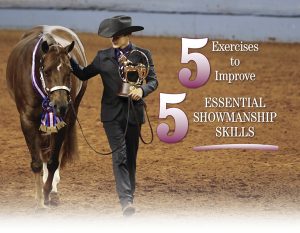5 Exercises to Improve 5 Essential Showmanship Skills
Click here to read the complete article
130 – May/June, 2022
When it comes to Showmanship, the discipline has come a long way from its humble 4-H beginnings–when it was used to teach youth how to present an animal in-hand–to the complex dance we see between horse and exhibitor today. In fact, what was once thought of as a basic class has become one of the most technical of the all-around disciplines, with five maneuvers utilized in almost every pattern: the set-up, the walk, the trot, the back, and the turn.
Individually breaking down those maneuvers and regularly practicing with specific exercises and drills is the key to success say today’s top Showmanship trainers: Sara Simons, Bruce Walquist, Jenny Jordan Frid, Carly Veldman Parks, and Cami Claypool.
The Set-Up
The first essential element of Showmanship is the set-up, and it’s the foundation for both the Halter and the Showmanship horse. “I want to impress upon readers that it’s the most important maneuver, and it’s a little bit of a lost art,” Sara Simons explains. “Because Showmanship is derived from Halter, presenting your horse to the judge is critical. If there’s a tie, I use that maneuver as my tie-breaker when judging.”
Simons utilizes a time-tested method of keeping the horse’s right hind foot stationary and teaching the animal how to move the other three. In addition, cues for moving front and back vary, with a side-to-side motion on the lead for the front feet, and forward and back pressure for the hind. “Once the horse has learned this, we keep that routine, because it’s a more simplistic approach for the horse,” she says. “They know how to move by the way we pull the chain slightly.”
One drill involves maintaining this routine by practicing the set-up tirelessly to make the set-up a habit that transfers to the show pen. “At the end of a lesson, for example, I might suggest that a client do 30 set-ups before they’re done for the day. No matter how much time is spent at the home, they must have the right feel when pressured to set up in front of the judge,” Simons explains. “A quick set -up is good, but I’m not offended if an exhibitor takes a little more time to set up correctly, from a judging standpoint.”
The Walk
Click here to read the complete article
130 – May/June, 2022











